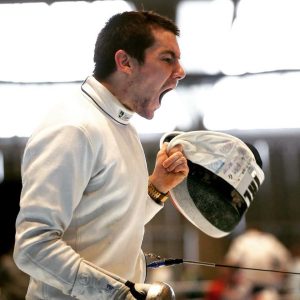About Fencing
Fencing in Ireland is extremely social, with plenty of Senior and Junior competitions, Inter Varsities, afterschool clubs, Camps or just friendly bouts available throughout the country.
Modern Fencing - The Sport

Fencing has been included in the modern Olympic Games since their inception in 1896. Along with swimming, gymnastics, and athletics, it is one of only four sports to have been contested at every Summer Olympiad.
The 1912 Olympics introduced the Modern Pentathlon, which features a one-hit variant of épée fencing intended to simulate a duel to first blood.
Since then, the sport of fencing has continued to develop, with continual improvements in safety standards, athlete training, and fencing technology. The most notable change over the last century has been the development of electronic scoring, which has allowed for a dramatic increase in the pace of the action, while weapons and protective gear have become lighter and safer.
Modern day fencing has been constantly refined and perfected, with every generation of fencers striving to improve on their forebears.
Fencing Disciplines
Épée
The rapier was developed in Italy during the 16th century, and is still used in the sport today, though now known by a different name – the épée (simply the French word for sword). Its evolution to the modern-day weapon aroses from the adaptations that were required to improve its offensive and defensive capabilities. Originally it was a very light, long blade, which could inflict damage using both the point and edge. It required athleticism and expert technique to be wielded effectively. Of the three weapons used today, the modern épée – in spite of many improvements – remains the closest to its roots.
Foil
The foil was a training weapon for duellists. Training was carried out wearing protective padding and using a walnut on the tip of the blade to prevent injury. In this weapon, the emphasis was put on attacking the vital organ areas, specifically the torso. It gradually developed its own unique rules and style. As duelling became less commonplace, foil took over as a major competitive sport with a distinct difference from épée fencing: “right of way”.
Sabre
The sabre came to the sport from the 18th century Hungarian cavalry, and the modern weapon is descended from the Turkish scimitar. It is a simulation of horseback battle, as the target area for the weapon is above the waist. This allowed combatants to “spare the horse and not the man” at a time when good cavalry horses were difficult to come by, especially on the battlefield. Sabre style is also subject to the “right of way” rule. The play is fast and furious, and like foil, is punctuated by halts from the referee.
Frequently Asked Questions
What is fencing?
Fencing is a sport where two competitors at a time use sporting swords (foils, épées or sabres) to score points, typically 5 or 15, within a set time. Fencing is both highly technical and tactical - a dynamic, fun sport that engages people at all stages of life.
Our Sport appeals to a variety of individuals young and old as it provides a different avenue of engagement in sport, to the more common team field sports.
Benefits of fencing
Fencing has a range of unique benefits, especially with regard to mental development as well growing a sense of personal responsibility and independent problem solving skills. Fencing burns off a lot of energy, so an ideal activity to tire out energetic children and ensure that they are enjoying a healthy lifestyle. Good posture, balance and flexibility are key physical attributes that your child will develop while fencing. Other benefits are improved reflexes and co-ordination, all fitness elements that they can bring across to any other sport or activity in their lives.
Do you have to be fit to take part?
You don’t have to be particularly fit to take part. Fencing training will improve your fitness level and stamina as it typically involves general fitness training as well as fencing techniques.
Is it dangerous?
Fencing accidents are extremely rare and usually associated with faulty equipment. As in most sports, occasional bruises and bumps may happen, but serious accidents are much rarer than in most sports – that said, it is important that the appropriate protective items are used.
Isn’t it a rather elite sport?
Fencing is one of the largest sports in the world in terms of participation. It is the national sport in Hungary and is very popular in France, Germany, Italy and elsewhere in Europe. It is quite strong in North America and just about every country in the world has an active fencing organisation. It is relatively small in Ireland, but Irish fencers are welcome everywhere!
I’m joining a club to see what it’s like. What do I need to bring?
Apart from yourself, wear a tracksuit or similar clothing which allows freedom of movement. After that the club will advise you on what else is needed and will generally have a supply of equipment available until you decide you want to get your own.
So how do I get started
Contact your local club listed in our Get fencing Section or contact our Head office Email
